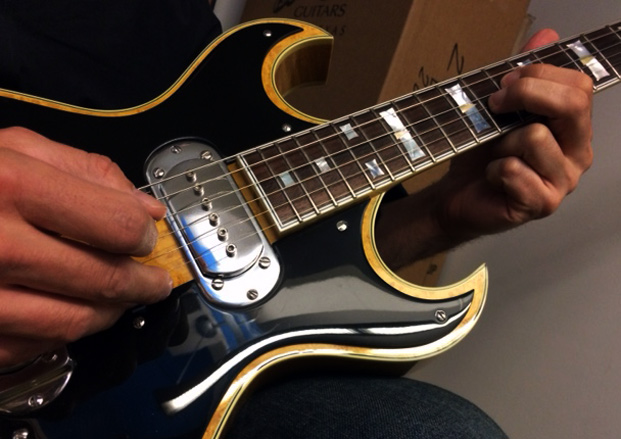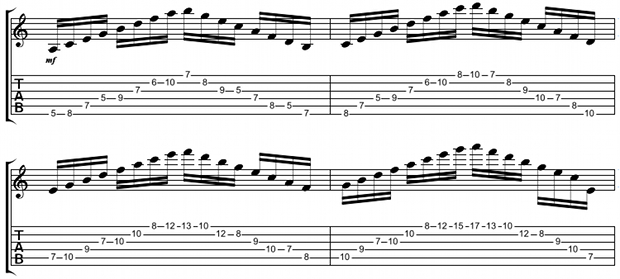Improve Your Fretboard Knowledge with This Arpeggio Exercise
Learn an arpeggio exercise that will help improve your music theory and knowledge of the fretboard.

In this lesson, I'm going to teach you an arpeggio exercise that will help improve your music theory and knowledge of the fretboard.
Players often play exercises only to improve technique, but it's important to vary your exercises to focus on other important parts of guitar playing. Although this exercise is based on arpeggios, it is meant to help you visualize scales differently from the standard "three note per string" shapes.
How can learning an arpeggio exercise help with scales?
The answer is simple: Arpeggios are derived from scales. A big problem for guitarists is not being able to switch between the two in a musical way. When you listen to solos, particularly in rock/metal, when guitarists play arpeggios, they are usually played with a sweeping or tapping technique, playing exclusively arpeggio sequences. Then when you hear scales, it's the same problem, but usually they are being played as ascending or descending alternate-picked sequences.
Hardly ever will you hear a player integrate the two and sound musical and melodic. It all comes back to the age-old problem of guitar players whose solos sound like a bunch of exercises stuck together. There's the metaphor about players who sound like robots. These "robot" guitar players usually have two modes of lead playing: "scale mode" and "arpeggio mode." In the following weeks, I'm going to be working on a series of lessons to help you play less like a robot.
My exercise is very simple and based off building arpeggios from scales. A simple way to look at building arpeggios is by stacking third intervals or simply skipping notes within a scale. For example, from the A minor scale (A B C D E F G), you would make an A minor arpeggio (A C E). You skip the B and D notes to make the arpeggio. You can carry on skipping notes within the scale to make larger arpeggios until you have eventually used every note from the scale to make an A minor 13th chord (A C E G B D F).
This exercise applies that same system to every note within the key of A minor to make seven different 13th arpeggios. From every note of the A minor scale we build a 13th arpeggio by stacking thirds and play them in order.
When playing this exercise, don't just memorize the frets from the tab; learn each note you are playing and visualize how ascending and descending through each arpeggio relates to the key scale of A minor. The way I have arranged the notes on the fretboard is not important, and if you have a good understanding of the theory behind the exercise, you should experiment with your own fretting.

The goal of this exercise is to help develop your fretboard knowledge of scales. For that reason, each arpeggio is built strictly using only notes from the A minor scale. Some of the arpeggios in this exercise are not "normal" 13th arpeggios, which would usually involve flattening of certain intervals. However, if you can visualize how an arpeggio is derived from a scale, you can better incorporate them into your solos without relying on arpeggio shapes, which will usually end up sounding like exercises.
Will Wallner is a guitarist from England who now lives in Los Angeles. He recently signed a solo deal with Polish record label Metal Mind Productions for the release of his debut album, which features influential musicians from hard rock and heavy metal. He also is the lead guitarist for White Wizzard (Earache Records) and toured Japan, the US and Canada in 2012. Follow Will on Facebook and Twitter.
Get The Pick Newsletter
All the latest guitar news, interviews, lessons, reviews, deals and more, direct to your inbox!
“There are so many sounds to be discovered when you get away from using a pick”: Jared James Nichols shows you how to add “snap, crackle and pop” to your playing with banjo rolls and string snaps
Don't let chord inversions bamboozle you. It's simply the case of shuffling the notes around







![Joe Bonamassa [left] wears a deep blue suit and polka-dotted shirt and plays his green refin Strat; the late Irish blues legend Rory Gallagher [right] screams and inflicts some punishment on his heavily worn number one Stratocaster.](https://cdn.mos.cms.futurecdn.net/cw28h7UBcTVfTLs7p7eiLe.jpg)


